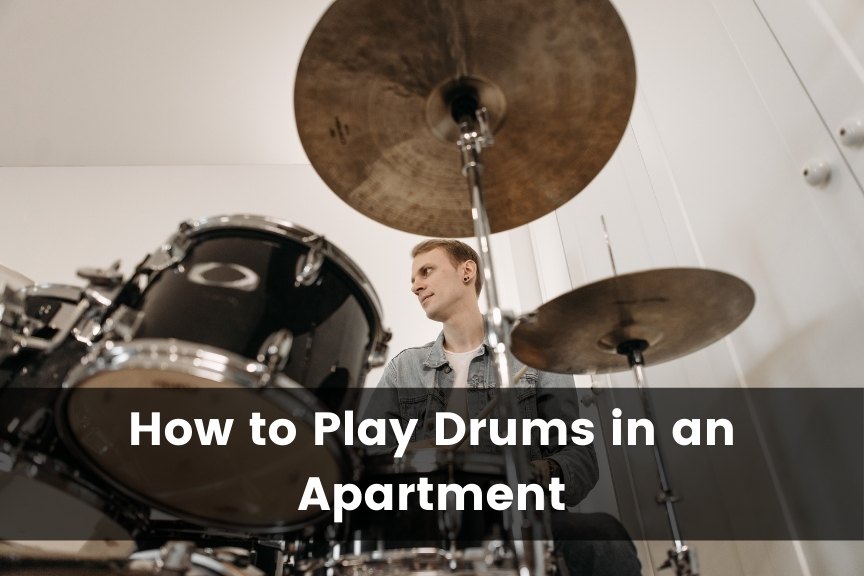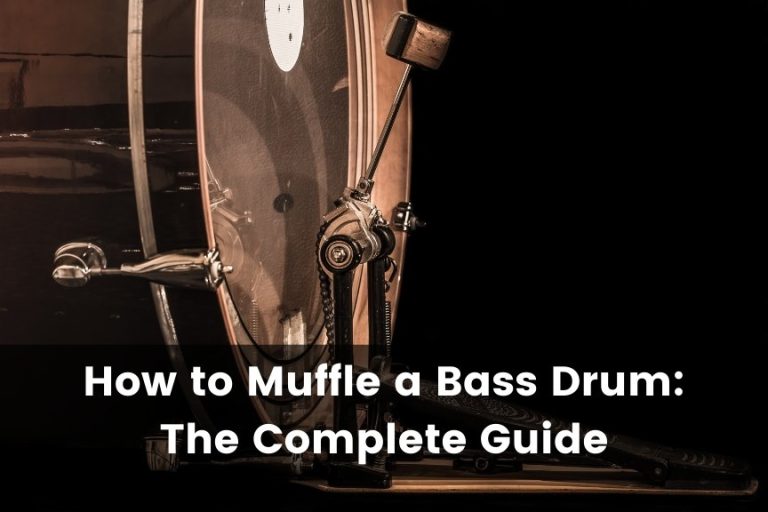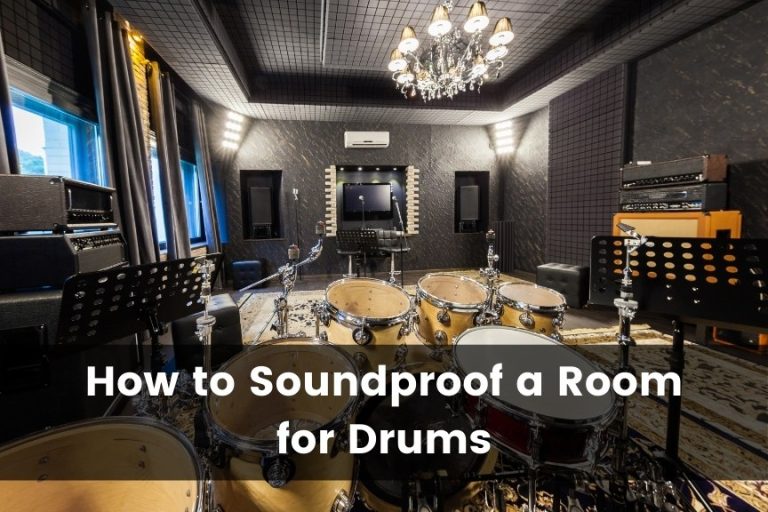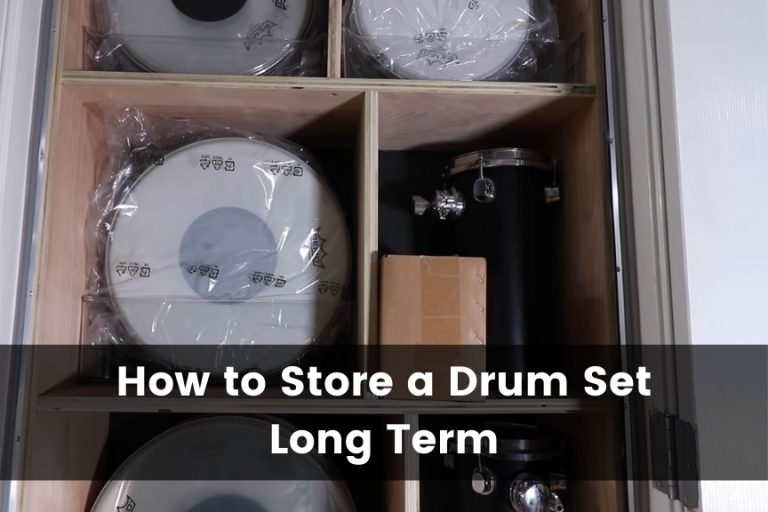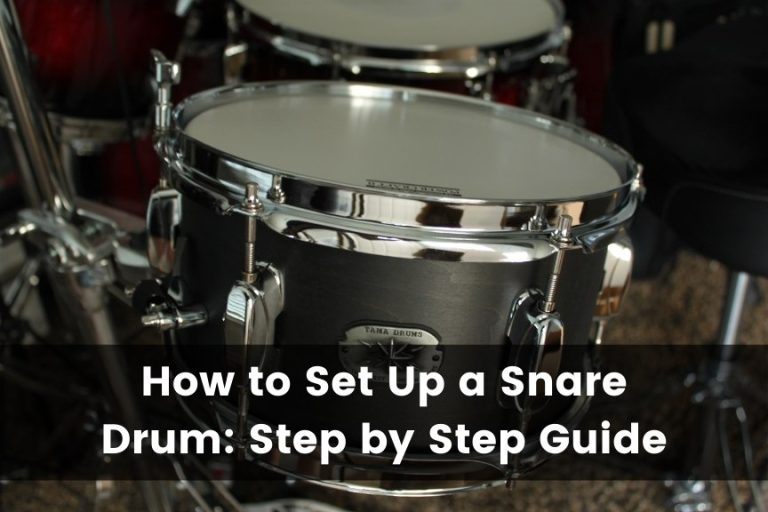How To Play Drums in an Apartment (10 Simple Tips)
Drums are one of the most entertaining instruments to play. However, they are not the quietest, and this can be a setback if you’re playing them in your apartment. Luckily, there are a few tricks you can use to enjoy your drumming session without getting complaints from your neighbors.
Here are 10 simple tips on how to play drums in an apartment:
- Use a portable isolation booth.
- Do some acoustic treatment in your room.
- Cover your drum surfaces with towels.
- Use mesh drumheads.
- Use drum mute pads.
- Play with quieter drumsticks.
- Use low-volume cymbals.
- Buy an electronic drum set.
- Consider using a practice pad.
- Work around your neighbors’ schedules.
So, let’s discuss how you can make each of these tips work perfectly for you. I’llI’ll help you set up your kit to ensure that you don’t get noise complaints from your neighbors while practicing in your apartment. So, let’s get into it.
1. Use a Portable Isolation Booth
Isolation booths are not only helpful for vocalists. They can make the perfect practicing space for drummers too.
An isolation booth is a structure specially built to contain sound within it. They consist of soundproof materials that form a cubicle to play your drums in.
An isolation booth for drums is called a drum cage. It is an enclosed space made out of acrylic panels and sound-absorbing material. A portable isolation booth not only keeps your drumming from escaping your apartment but also totally shuts out noise from the outside world.
Portable isolation booths are a little pricey compared to the other solutions on this list. Still, they are also highly effective.
If you are serious about solving your noise problem completely, a good isolation booth will cost you about $3500.
If you’re not ready to make this investment, you can build your own isolation booth using tools and materials from your local convenience store. Making one yourself is more time-consuming, but it can be a fun project, and once you finish, you will be very impressed with the results.
This video shows you how you can construct your own isolation booth for just $500:
2. Do Some Acoustic Treatment on Your Room
Acoustic treatment will not entirely prevent your drum noise from escaping your apartment. It will insulate your apartment, preventing other sounds such as loud music, TV sounds, and conversations from escaping to your neighbors’ spaces.
Soundproofing involves lining the surfaces of your apartment walls, floors, and corners with a particular material that absorbs the sound coming from your drum kit as you play.
These are some of the areas you’ll need to consider when acoustically treating your drumming room:
Walls
Walls are notorious for amplifying the sound of a room. Being the most rigid surface in your building, they reflect the most sound.
You can dampen the noise bouncing off the walls by using acoustic panels. These are available in all shapes and sizes, but I recommend the Auralex Acoustics Wedgies from Amazon.com. The brand has stood the test of time and is a favorite among many sound enthusiasts.
You don’t need to cover up your entire wall with these panels. All you need is to evenly distribute them across a wall, leaving some spaces in between. Just remember to stick them up using an adhesive that will not damage the walls when you take them down in the future.
Consider acoustic panels made from fiberglass or mineral wool to get even more effective sound absorption on your walls. These two materials are highly effective in containing low frequencies from your toms and bass drums.
Floor
Much sound is transmitted through the floor, especially to the rooms below. The bass drum is prone to letting those lower frequencies through the floor. One of the ways you can reduce this noise is by using a drum mat.
A drum mat is simply a thick rug underneath the drum set. An old carpet will do the trick, but there are many commercial rugs out there that work well. If you don’t know where to start, try the Kay&J Drum Rug Carpet from Amazon.com.
You may also choose to carpet your entire floor to increase the surface area for sound insulation. However, not every landlord will appreciate it if you install carpeting into your apartment, so check with your building’s owner before making any significant changes.
Windows
Windows are often ignored when treating a room for sound. However, even a narrow opening on a window can let out loud bangs and hits from a drum kit. The most affordable way to solve this problem is using thick curtains.
Again, if you have a set of thick curtains, use those. Alternatively, you can purchase ready-made acoustic curtains specifically to trap sound escaping through windows.
You can go the extra mile by sealing off gaps around your windows to prevent sound from escaping to your neighbors. Do this by using acoustic sealant or weather strips. This method will block the natural air exchange through your window, so only use it if your apartment is air-conditioned.
You may also control the noise leaving your window by replacing your window panes with double or triple glazed panes. Unlike standard window panes, the latter are infused with a layer of gas between them. As a result, this insulation reduces sound transfer by more than 50%.
Door
Just like your windows, the door can make your drumming very audible to your neighbors. Most doors are hollow, so they transfer sound easily from one room to another. To manage the sound moving through your door, you can use weather strips between the door and doorframe.
Weatherstripping helps to provide a layer of sound insulation around the spaces of your door. It creates an airtight blockage that prevents sound from moving out.
Another method of keeping sound from escaping through the door is using a door gasket. Although door gaskets are more expensive than weather strips, they are slightly more effective in containing the sound.
Door gaskets are permanent, and they attach to the top and sides of your door jamb. As you shop for a gasket, look out for adjustable ones. Adjustability is an essential feature because not every door will have perfectly linear edges.
To add to the work done by the door gasket, install a door sweep. This bumper will close off the space at the bottom of the door so that you have a fully functional soundproof door.
3. Cover Your Drum Surfaces With Towels
Putting towels on your drums is not just a noise reduction technique – it adds flavor to the drum sound. When you cover your snare drum with a small towel, it gives you a short, percussive hit that is different from the traditional sound. Many bands in history have used this trick, including the legendary Beatles.
Try not to overly cushion the drum surface, as you’ll get an unnatural hit. Instead, go for thin fabrics such as those on tea towels.
4. Use Mesh Drum Heads
Try replacing your drum surfaces with mesh drumheads. As you might know, traditional drumheads are made from Mylar, which vibrates loud enough to make your drums audible from across the room.
On the other hand, Mesh drum heads consist of a porous, woven material. When struck, mesh drum heads give you a much quieter sound. Mesh drum heads come in a wide range of dimensions. So, you can place them on your snares, bass drum, or toms.
While it may not give you the authentic sound of an acoustic drum, the mesh will also not be as loud as traditional Mylar. You can also switch them out later if you have a performance and use the mesh for practice.
Try this Remo Mesh Drum Head from Amazon.com to get a good balance of tone and volume.
5. Use Drum Mute Pads
Silencing pads, or mute pads, help reduce the sound made when you hit a drum. They come in different shapes that are custom-made for your cymbals, toms, snare, and bass drum.
Mute pads are essentially thin sheets of rubber that you attach to the surface of your drums. As you play, the goal is to hit the area of the mute pad instead of the actual drum or cymbal. Naturally, this gives you a softer sound that your neighbors will probably not find annoying.
You can take off the mutes whenever you feel like it. They also give you the advantage of training your hand muscles because they cushion your hits other than letting you rely on the drum’s rebound.
Drum mutes don’t make your drums entirely silent, and they take the acoustic feeling out of your drumming session. However, when they are used together with other soundproofing techniques, you’ll have your drumming volume under extreme control.
As you use drum mutes, one particular place you need to pay more attention to is the bass drum.
You may use felt strips to dampen the sound on your bass drum. Today, some bass drum heads come with a pre-installed felt strip that is thick enough to give you a warm kick sound.
However, the strips won’t make much of a difference if the space in the bass drum remains open. To muffle the bass drum sound more, try these DIY techniques:
- Wrap a thin bed sheet around the inside of your bass drum to eliminate ringing tones.
- Place a thick blanket or pillow inside your bass drum, which will make it sound deeper and quieter.
These methods will reduce the space available for the low, bassy frequencies to vibrate.
6. Play With Quieter Drumsticks
The size and type of drumsticks you use can affect how loud your drums sound. Here’s how:
Type of Drumsticks
- Sticks are the most popular and loudest type of drumstick. They may be made out of maple, oak, and other types of wood.
- Rods are quieter than sticks but louder than brushes. They consist of bundles of small sticks wrapped closely together.
- Brushes offer the quietest sound among all drumsticks. These Vater Bamboo Brush Drumsticks from Amazon.com are a great choice regardless of your playing level.
Size of Drumsticks
The thickness of your drumstick can determine the loudness of your playing. Thinner drumsticks generally produce a lower sound volume because they don’t hit the drum with as much force as the large ones.
An alpha-numeric code identifies the size of a drumstick. So, for example, you can have a 5A, 8D, or 2B drumstick. The letters come from the early 20th century, with:
- A representing Orchestra
- B representing Band
- D standing for Dance Band
Today, you can use any of these types regardless of the genre of music you play. The thickness of the drumstick increases as the numbers go down, with 2B being the thickest.
5A is one of the most typical sizes, so if you’re looking for thin and quiet drumsticks, go for a 7A or an 8D.
You might also want to hold the sticks a little closer to the end that hits the drum. This technique gives you more control over your grip and reduces the rebound on your strike.
7. Use Low-Volume Cymbals
Cymbals are theoretically the loudest part of a drum. They emit between 110 and 125 decibels compared to snare drums that shoot out 90 to 120 decibels. Bass drums emit about 105 decibels of noise.
The reason why cymbals come off as loud has a lot to do with our biology as humans. We generally perceive higher frequencies as louder than low sound frequencies, even at the same decibels.
Humans are more sensitive to sounds around the 2 – 4 kHz region, where the bright, shiny sound of a cymbal lies.
So, when you’re playing drums in your apartment, you might want to use a different kind of cymbal on your drum set. Low-volume cymbals have multiple holes in them to eliminate most of the high-end tones. They not only reduce the amount of sound from your drums but also allow you to practice longer without getting ear fatigue.
This pack of Zildjian L80 Low Volume Cymbals from Amazon.com is ideal for use in a home environment. According to the manufacturer, they reduce your cymbal sound by up to 80%.
Alternatively, you can use a cymbal mute to bring down the noise on your cymbals. These are simply thin, rubber mats that you stick on your cymbal to allow a quieter sound when you hit it.
8. Buy an Electronic Drum Set
An electronic drum set is noticeably quieter than an acoustic one. Electronic drum sets are set up in the same way as acoustic drums, except they sound different. They usually have rubber or silicone pads for surfaces, which means they don’t produce as much volume when struck.
The pads of an electronic drum set have sensors that detect drumstick hits and play a sampled sound when struck.
Although you’ll still hear the sound of your drumstick striking the pad, you get more control over the volume that comes out of every hit. Electronic drum sets produce sound through a speaker, amplifier, or pair of headphones.
In addition to giving you better volume control, electronic drum sets occupy less room than acoustic drums. This space efficiency can be beneficial if you intend to drum in a small apartment. Electronic drums have the added advantage of storing thousands of sampled sounds, making your drumming experience enjoyable.
9. Consider Using a Practice Pad
A practice pad is a piece of equipment that mimics the sound of a drum without as much noise. It is portable, allowing you to practice single drum routines without waking up your neighbors.
A practice pad is designed to make your drum hits quiet even in a confined apartment block. Most practice pads are about 6 inches (15.24 cm) wide. Their playing surfaces are usually natural or synthetic rubber that mimics the rebound of an acoustic drum.
Still, practice pads are nothing like acoustic drums regarding their sonic quality. In addition, you won’t get much better in terms of coordination because they only allow you to play a single drum at a time.
Still, practice pads are an excellent alternative if you want to take your practice from the studio to your apartment at a fraction of the price.
10. Work Around Your Neighbors’ Schedules
Talking to your neighbors and trying to find the perfect playing time might be the cheapest and least time-consuming trick to play drums in your apartment.
Talk to your neighbors and find out when they are in or out of their apartment. Try to find moments when you can practice your drumming while they are away.
You can even come to a compromise where you can practice while they are around on less stressful periods like weekend afternoons.
Final Thoughts
Drumming inside an apartment building is never easy because of how loud the drums can get. There are a few techniques that you can use to keep your drumming sounds under control, even if your walls are paper-thin.
These techniques range from acoustically treating the room to modifying your drumset and even negotiating with your neighbor. You’ll find that most of these methods will work well when combined to give you a comfortable drumming session for both you and the neighbors at your apartment.

